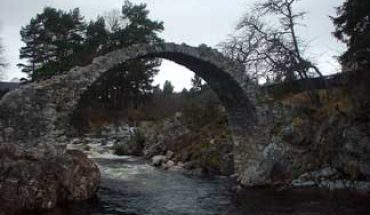Submitted by Owen McCafferty on Thu, 2009-11-19
In march of 1298, in the Abbey at Selkirk, William Wallace was dubbed knight by Robert Bruce and proclaimed Guardian of the Realm.
Southern Scotland was suffering from a famine, so Wallace used his army to raid Northern England to in an effort to supply food to the starving people.

The original site of Selkirk Abbey, where Wallace was declared a guardian of Scotland
In March of 1298, Edward finally made peace with the French and returned to England. Unfortunatly for the Scots, this left him free to turn his attention northward. Edward mustered his army in June. It comprised of some 2500 heavy cavalry and 12000 foot soldiers. The army marched north, but only found empty farms and villages. Hearing the English were coming, the inhabitants had driven their cattle into the forests and burned their crops. Edwards army was running out of supplies and facing starvation, his resupply ships had been delayed by bad winds and the whole expedition was on the verge of collapse. Edward had already decided to turn around when word was received that the Scots army was only 13 miles away and that the food ships had just recent docked nearby. Edward immediately broke camp and marched to meet the Scots. An accident with his horse in the middle of the night left Edward with two broken ribs but he still had himself hoisted into his saddle in the morning.
The two armies met the following morning. Wallace was concerned about the number of the English heavy cavalry and formed his men into four schiltrons. Immediately to his front was a boggey marsh, to his right scattered woodlands and to his left a deepening valley. His meager amount of cavalry he placed behind him as they were too few to be effective in attack. It is believed Wallace wished to retreat, destroying the land as he went and let hunger defeat the English, but he was overruled by his troops who were impatient for battle.
Edward divided his heavy horse onto four groups of 600 each. Two of these groups then charged, one moving left around the bog, the other to the right. They came upon the rear of Wallace’s army and scattered the light Scottish cavalry into the woods. Turning inwards, they then overwhelmed the Scottish bowmen whose short bows were not powerful enough to penetrate the English armor. This left the schiltrons exposed. Again and again they were charged, but the schiltrons held. It was then that Edward ordered up his bowmen and a deadly rain of arrows and bolts rained down upon the Scots. This left gaps too wide to be filled and the heavy cavalry charged again. Once the schiltrons were breached, it was all over. Hundreds of the Scottish foot were slaughtered and Wallace was driven into the woods with a handful of followers.

The tomb of Scottish knight Sir John de Graham at Falkirk parish whose body was brought here after the battle.
With the Scots army dispersed or destroyed, Edward took time to rest and for his ribs to heal. In the meantime, he sent forces to burn Perth and St. Andrews. He then turned his attention to capturing Robert Bruce, who had been raiding the southwest from his base in Ayr. But Bruce was warned of Edwards approach and disappeared into the woods after burning and destroying the town and castle. When Edward arrived, all he found was an empty shell.
Faced by winter and a lack of supplies, Edward was forced to disperse his army until the following summer.
‹ Chapter 5 – Stirling Bridge up Chapter 7 – The death of William Wallace ›




